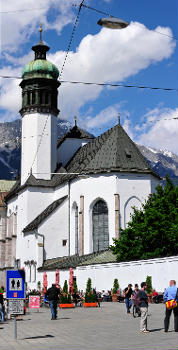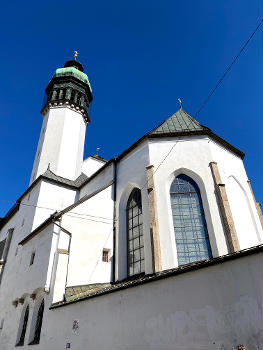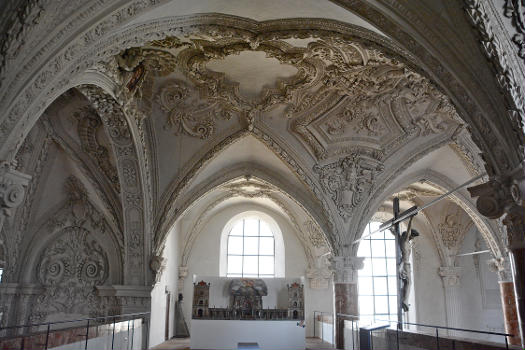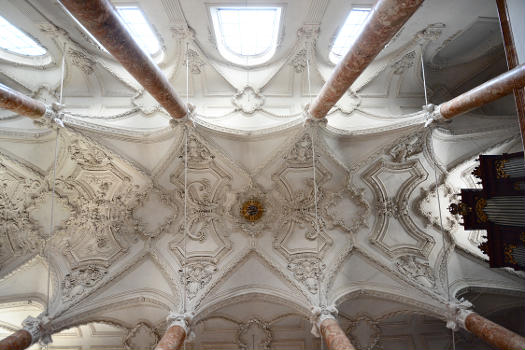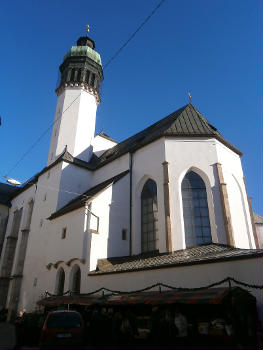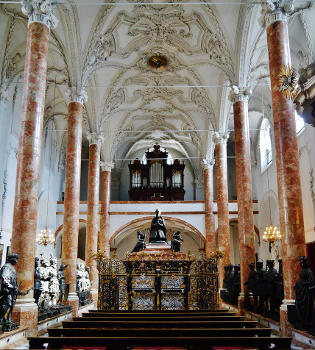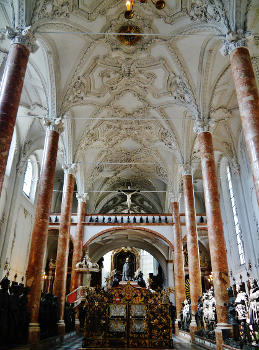General Information
| Other name(s): | Schwarzmander-Kirche; Franziskanerkirche |
|---|---|
| Beginning of works: | 1553 |
| Completion: | 1563 |
| Status: | in use |
Project Type
| Function / usage: |
Church |
|---|---|
| Material: |
Masonry structure |
Awards and Distinctions
Location
Technical Information
There currently is no technical data available.
Excerpt from Wikipedia
The Hofkirche (Court Church) is a Gothic church located in the Altstadt (Old Town) section of Innsbruck, Austria. The church was built in 1553 by Emperor Ferdinand I (1503–1564) as a memorial to his grandfather Emperor Maximilian I (1459–1519), whose cenotaph within boasts a remarkable collection of German Renaissance sculpture. The church also contains the tomb of Andreas Hofer, Tyrol's national hero.
Although Maximilian's will had directed that he be buried in the castle chapel in Wiener Neustadt, it proved impractical to construct there the large memorial whose plans he had supervised in detail, and Ferdinand I as executor planned construction of a new church and monastery in Innsbruck for a suitable memorial. In the end, however, Maximilian's simple tomb remained in Wiener Neustadt and the Hofkirche serves as a cenotaph.
Church
The Hofkirche is located at Universitätsstraße 2, adjacent to the Hofburg in the Altstadt section of Innsbruck. The church was designed by architect Andrea Crivelli of Trento in the traditional German form of a hall church, consisting of three naves with a setback three-sided choir, round and pointed arch windows, and a steep broken hip roof. Its layered buttresses reflect compromise of contemporary Renaissance design with German late Gothic style. Stonemasons Hieronymus de Longhi and Anton de Bol carved the fine Renaissance portal.
The church interior contains galleries, high slender colonnettes of red marble with white stylized Corinthian capitals, and a lectern. The gallery's original ribs made from sandstone from Mittenwald have been preserved, but after the main vault was damaged by earthquake in the 17th century, it was rebuilt in the Baroque style.
The high altar seen today was designed in 1755 by the Viennese court architect Nikolaus Pacassi, and decorated with a crucifixion by the Viennese academic painter Johann Carl Auerbach, and bronze statues of Saint Francis of Assisi and Saint Teresa of Ávila by Innsbruck court sculptor Balthasar Moll (1768). The Renaissance organ (1560) is by Jörg Ebert of Ravensburg, and described locally as one of the five most famous organs in the world. Domenico Pozzo from Milan painted the organ panels.
A side chapel, called the Silver Chapel (Silberne Kapell), was consecrated in 1578. It contains a silver altar to Mary incorporating three elephant tusks and three hundred kilos of ebony, and the tombs of Archduke Ferdinand II and his wife Philippine Welser—both by Alexander Colyn.
Cenotaph
Emperor Maximilian's ornate black marble cenotaph occupies the center of the nave. Florian Abel, of the Prague imperial court, supplied a full-sized draft of the high tomb in the florid style of court Mannerism. Its construction took more than 80 years. The sarcophagus itself was completed in 1572, and the final embellishments—the kneeling emperor, the four virtues, and the iron grille—were added in 1584.
Trento mason Hieronymus Longi directed construction of the tomb proper. The base of the tomb consists of Hagau marble, a Jurassic limestone found in the North Tyrol and used as a building stone throughout western Austria. The bronze relief frieze of trophies includes vases, suits of armor, weapons, shields, musical instruments, etc., and above that two rows of white marble reliefs. The 24 reliefs were created by the artist Alexander Colin, based on woodcuts from The Triumphal Arch (Ehrenpforte) by Albrecht Dürer, with four stone bas-reliefs each on the tomb's ends, and eight on its longer sides. They depict events from Maximilian's life.
The tomb is enclosed within a fine wrought iron grille created by Jörg Schmidhammer of the Prague court, based on a drawing by the Innsbruck painter Paul Trabel, and capped with statues of the four virtues and kneeling emperor cast in Mühlau from models by Alexander Colin.
Statues
The cenotaph is surrounded by 28 large bronze statues (200–250 cm) of ancestors, relatives and heroes. Their creation took place over between 1502-1555, and occupied a number of artists including Christian Amberger, Albrecht Dürer, Jörg Kölderer, Jörg Polhamer the elder, Gilg Sesselschreiber, Ulrich Tiefenbrunn, and sculptors Peter Vischer the Elder, Hans Leinberger, G. Löffler, Leonhart Magt, and Veit Stoß. Three of the statues are based on designs by Dürer. According to David Gass, one of many descendants of both Maximilian and Louis II of Hungary, the inclusion of the King Arthur and Godfrey of Bouillon statues are due to Louis II's sister, Anna, the Queen of Bohemia marrying Ferdinand, Maximilian's grandson, and bringing her English heritage with her. Both men were said to be her ancestors.
The gallery contains 23 small statues (66–69 cm) of the Habsburg patron saints. They were designed by court painter Jörg Köldere around 1514/15, and carved into wood and then wax by Leonhard Magt. The church also once contained a number of busts of Roman emperors; 20 are now displayed in Schloß Ambras and one is in the Bavarian National Museum in Munich.
Andreas Hofer tomb
Andreas Hofer, Tirol's national hero, is also buried within the church. Sculptor Johann Nepomuk Schaller made his statue; Josef Klieber created the relief of the "Fahnenschwur" (Swearing on the flag) based on a sketch by Josef Martin Schärmer.
Text imported from Wikipedia article "Court Church" and modified on June 2, 2020 according to the CC-BY-SA 4.0 International license.
Participants
- Andrea Crivelli (architect)
Relevant Web Sites
- About this
data sheet - Structure-ID
20033268 - Published on:
18/11/2007 - Last updated on:
22/05/2024

